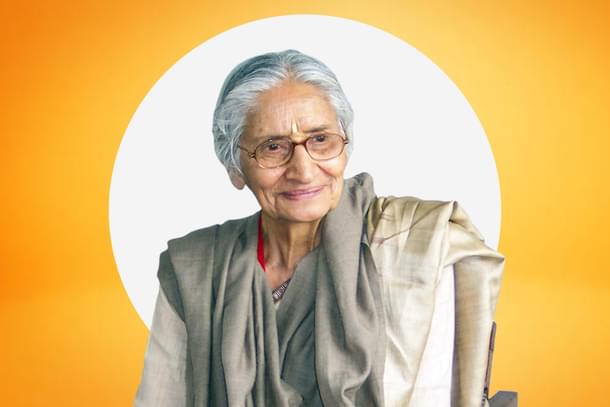Obit
Kapila Vatsyayan: An Icon Scholars Of Indian Culture Look Up To
Aravindan Neelakandan
Sep 25, 2020, 06:37 PM | Updated 05:32 PM IST
Save & read from anywhere!
Bookmark stories for easy access on any device or the Swarajya app.


With the demise of Kapila Vatsyayan, an important living link in a lineage in the domain of Indian cultural studies, has passed into eternity. That lineage had been nurtured in the past by remarkable personalities such as Ananda Coomaraswamy, Rabindranath Tagore and Stella Kramrisch.
She belongs to a school of thought that is deeply rooted in India’s culture and spirituality — and it has been exploring the phenomena of life around and within through a framework that is ancient, holistic and transcends time.
She was close to the Nehru dynasty — particularly Indira Gandhi and Rajiv Gandhi. But that proximity was put to good use in the service of India's cultural history — she served as the founding director of Indira Gandhi National Centre for the Arts (IGNCA).
One should remember that her very active decades coincided with the Nehruvian-Marxist takeover of every domain of humanities including traditional and tribal art forms.
In the Indian context, the approach has at its core the conflict between the so-called Aryan and non-Aryan, the Brahminical and the non-Brahminical, the Vedic versus the tribal, Sanskrit culture versus the folk culture etc.
The school of thought which Kapila Vatsyayan represented, stands diametrically opposite to such a conflict-oriented paradigm. It is based on the reality of lived Hindu experience in the highest sense of the term.
Consider for example the way she views the dynamics of India’s performing arts. In the introduction to her work Traditional Indian Theatre: Multiple Streams, she says:
A recognition of the framework of the interconnection of levels, the interrelatedness of regions, interdependence of art forms, and the principles of eternity (of timelessness) and of flux (everchanging, ever-renewing manifestation) demanding a concentrated still centre and peripheral multiple expressions, is essential for a true understanding of the traditions of the performing arts of India.
One should note how she shows that the understanding of the spiritual heart of India — its everchanging yet timeless core, the Dharma Sanatana — overawes and makes irrelevant the so-called Aryan/non-Aryan or more sophisticated Brahmin/non-Brahmin, classical/folk to the study and understanding of Indian art forms.
More importantly, her worldview thus rooted in the deepest spiritual principles of India was not an armchair theorising as in the case of most ‘scholars’ of ‘the theory’. Going through her work, anyone will be astonished by her in-depth knowledge of regional diversity of Indian art forms.
Consider this from the same book, taken from the chapter on Kutiyattam:
Both the Silapathikaram and the Patitrupattu provide valuable internal evidence on the state of poetry, music and dance. The musical forms prevalent in Kerala prior to the advent of the Gita-Govinda in the 15th-16th century have much in common with the musical culture of Tamil Nadu. In course of time it evolved its own techniques, the most important of them being the style of singing adapted for Kathakali today.
She explains how almost every part of India has contributed to the evolution of highly specialised art forms from any part of the country. She shows repeatedly and in a highly scholarly manner the ‘unity in diversity’ phenomenon that animates every aspect of the Indian culture.
Kapila Vatsyayan chose to write in English so that she could reach out to that sections of Indian mind seated in power and yet enslaved to alien thought process. She had to constantly battle with the limitations of Western contexts of the language when expressing Indic phenomena and their roots.
Consider this, for example, in her seminal work The Square and the Circle of the Indian Arts (1997):
I have thus come to the conclusion, rightly or wrongly, that ‘dance’, especially in the Indian context, cannot be viewed in isolation from the most significant framework of the philosophical thought and the psychical concerns of the Indian people.
Then just a page or two later she explains:
Let me begin, then with the ideational background of the Indian arts. I should like to avoid the more commonly used terms ‘philosophical’ and ‘sociological’ background, in this frame of reference, as they are loaded contextual terms. Their use as equivalence for Indian concepts has been cause of some confusion. I would thus like only to underline the fact that even the six darshanas (the ‘philosophical systems’) cannot be synonymous with the term philosophy in the Greek sense.
She was the editor of the seventh volume of The Cultural Heritage of India published by the Ramakrishna Mission Institute of Culture, Kolkata. In its preface, in her own gentle way, she criticised the neglect scholars of her school were receiving from the establishment humanities scholars:
However it is a matter of some regret that there has been an orchestrated voice of dissonance against the viewpoints of the generation of scholars … . Their work has been critiqued on account of its over emphasis on the metaphysical and the spiritual, in short, on inner meaning and significance, and less on the historico-social-political context. Indeed, outer context and the theoretical principle of conflict and contestation have been the principle implements of intellectual discourse. As pointed out before, some scholars have denounced their work as following a nationalist agenda. One can only hope that with ripeness and maturity, they will come to the sanguine realization that the spiritual and experience is perennial and the socio-economic-political is the ephemeral, time-bound and restricted.
This she wrote in 2006. It is relevant and will remain relevant as a caution for generations to come.
Under her stewardship, IGNCA became an island preserving the essence of India that is eternal amidst the Marxist takeover of every institution. She fought the aggression in her own style.
As the Nehruvian-Marxist deluge submerged our social science and humanities institutions, Kapila Vatsyayan like the Manu of our puranas and the Noah of Hebrew Bible, silently preserved in that ark called IGNCA, the essence and core seeds of our culture.
She conducted some of the best seminars and brought out volumes on the basic nature of science as well as the interaction of science, culture and society.
Particularly important are the Prakrithi series — a five-volume combination of the papers of five seminars which brought together the best minds in science, culture and philosophy.
One should note here that the scholar-scientists she brought together belonged to diverse philosophical worldviews.
In fact, the editor of the fourth volume was none other than the physicist Jayant Vishnu Narlikar, who though a Sanskrit scholar could not be said to be in sympathy with the spiritual worldview in at least one sense of the term. But such differences were completely ignorable compared to the magnificence of the cause which Kapila Vatsyayan envisioned through IGNCA.
In her preface to the first volume of the series, citing the paper by physicist educationist Kothari, she wrote:
Modern science, (Kothari) reminded us, has realized for the first time that the atom has a wholeness of its own. It is also ananta, its growth is a dynamic process and it is not merely an aggregation of electrons and protons. Time has now come, said he, when science has to be spiritualized, just as the ritual of the indigenous people had been spiritualized so as to sacralize nature. ... It is only modern science which is linking physical matter with consciousness, and if the IGNCA has begun this exploration then it must be complimented and congratulated for its courage. Such questions can only be asked in a spirit of humility, modesty and with an openness of mind where the barriers of disciplines and cultures, ideologies and positions are transcended. The symbiosis of knowledge, vision and values alone can bring about a consciousness of the wholeness. How can this happen? ... All this is possible only if man lives by the perennial consciousness that he is one amongst all particles of nature, and is also conscious of the probability and possibility that he can be Brahman.
In a neutral environment, these seminar series should have become part of the guiding principles for those who frame the science, art and humanities curriculum. At least the educationists associated with the present government should seriously venture into that.
Equally important was her concern for developing an Indic model for environmentalism — both at the level of science and activism. When asked to write a preface for the volume Water: Culture, Politics and Management brought out by India International Centre, she wrote:
My limited purpose here is to revive the collective psychical memory of this heritage; to draw attention to the myths, art and ritual, science, religion and philosophy in India, which were the strategies through which this holistic worldview of ecological balance was articulated. … The pivot on which Indian myth moves, not unlike that of the other parts of the ancient world, is ecological balance. Developments in Indian science, specially in mathematics, chemistry and biology, owe their systems to this holistic worldview of ecological balance. The philosophic systems, whether from the polarity of the realist Charaka or the Sankhya, assert it: The language of Indian myth and art manifest it in an unparalleled lucidity of narrative statement and depth of thought, meaning and clarity of message, which has validity, here and now.
Here she points out how the multiple components of Indian culture and spirituality namely the puranas, rituals, art forms, engineering and architecture are harmonised through a grand unifying vision and value — Rta. She also underlines the universal nature-venerating aspect of all ancient sacred traditions of which only the Indian tradition survives today.
Now that she has become immortal, the responsibility of reviving those seeds collected by her, and through them decolonising the humanities domain from the conflict-oriented ‘tamasic’ model and integrating it with the harmony-oriented Sanatana model, should begin.
May her sacred memory and her works guide and inspire us in that endeavour.
Aravindan is a contributing editor at Swarajya.





